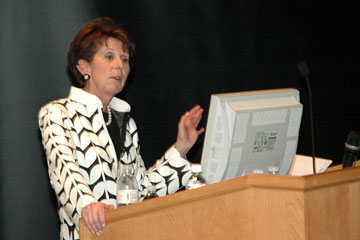
By Chris Casey | University Communications
AURORA, Colo. - The Anschutz Medical Campus is already well-versed in adaptability, and as big changes loom on the federal health care and budget landscapes, the campus is poised to meet the challenges with its trademarks of innovation and flexibility.
Lilly Marks, vice president for health affairs at the University of Colorado and vice chancellor of the Anschutz Medical Campus, delivered that message in her State of the University address this afternoon. She explained the strategic and operational challenges confronting the campus and said continued collaboration and creativity will be the key to surmounting the trying times.
The campus's story needs to be told, she emphasized. "We're the best-kept secret in Colorado."
Marks outlined the federal-level "convergence of economic and politics" that is creating a wave of uncertainty for medical centers. In 2011, Congress passed sequestration, which requires automatic, across-the-board cuts to the federal budget if a budget compromise isn't arrived at by the end of the year. Those measures include cuts of 8.2 percent to the National Institutes of Health, 2 percent to Medicare providers and 9.5 percent to the Department of Defense research, as well as 1,650 fewer grants. Currently, 34 percent of the Anschutz Medical Campus annual $1.2 billion budget is made up by grants and contracts.
Marks said the campus needs to be more creative and attentive to research funding, be it from industry or research foundations, even other campuses. "Seventy percent of grants on this campus come from federal funds, and the first rule of investing is to diversify risk, but most of our risk is sitting in the federal sphere."
That sphere is clouded by potential cuts to the NIH.
The NIH's award proposal options amid the budget crisis, and which are among the cuts being considered in the case of sequestration, are: do nothing; reduce or limit award sizes; limit the number of awards to a single principal investigator (PI); limit the total funds awarded to a single PI and limit PI salaries. If the NIH drops every grant by $25,000 it will cost the Anschutz Medical Campus $13.2 million, Marks said.
"All of this sets the stage for why we need to engage in a strategic look at our research enterprise and our research future," she said.
Also looming is the ongoing enormous pressure to reduce health care costs and insurance premiums as part of national health care reform.
While the challenges are daunting, Marks said, the Anschutz Medical Campus is well-positioned if it takes advantage of opportunities and leverages its immense resource of expertise.
"We have to become more cost efficient and we have to become more service oriented," Marks said. "We have to be compliant to the market imperatives."
The campus's clinical initiatives include the formation of the "major player" University of Colorado Health System, which now has five hospitals and a combined revenue base of $2.2 billion. "It's giving us the leverage of scales ... and Front Range referral network that hopefully will secure our future in this tenuous health care environment," Marks said.
Other opportunities are to explore new models of education and research, biotechnology innovation and enhanced philanthropy. The opportunities to meet operational challenges include the campus's master planning process, undertaking a thorough review of sponsored program and biotech transfer infrastructure, and building campus-specific infrastructure.
Also, the university must confront disruptive technologies, enhance communication and continue to foster research, excellent education for students and outstanding clinical outcomes -- which exceed rates of other medical centers -- amid "probably among the most challenging times I've ever seen."
But the challenges are universal -- they're facing medical centers nationwide, Marks said. The best and most innovative campuses, such as Anschutz Medical Campus, are the ones that will survive and thrive, she added.
"We can and must be the architects of change rather than the victims of change," Marks said. "I think there are opportunities to move up .. We have the talent, we have the collaboration and the will to move up."
To see the entirety of Marks' presentation, click here.
Contact: christopher.casey@ucdenver.edu




